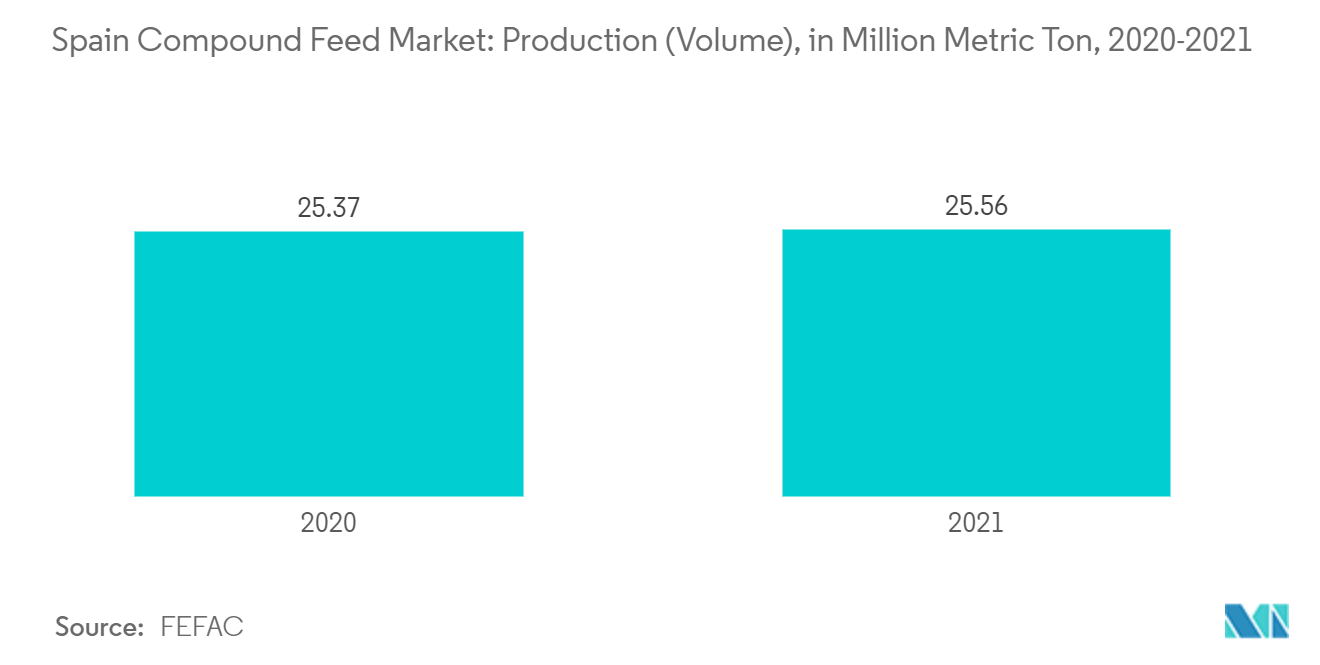Market Trends of Spain Compound Feed Industry
Growing Meat Export is Driving the Feed Market
- The rising commercial production of livestock has led to an increase in the export market, as there is a growing demand for animal products such as meat, milk, and eggs in other countries. According to International Trade Center (ITC) Trade, in 2021, the export market value for meat in Spain reached USD 10.43 billion, primarily due to heightened demand from China, France, Portugal, and Italy.
- Spain is the world's fourth-largest pork producer known for its high-quality ham and other cured meat products. Other popular meat exports from Spain include beef, poultry, and lamb. The Spanish meat industry, and in particular, the pig production industry, has made significant strides in modernizing and automating production processes. This has led to increased efficiency, productivity, and cost-effectiveness, making the industry one of the most advanced in Europe. This calls for a heightened demand for Spanish meat in Europe and worldwide.
- For Instance, in 2021, the swine meat export of Spain was valued at USD 6.5 billion compared to USD 6.45 billion during the previous year. Of USD 6.5 billion exported in 2021, China is the major importer of swine meat, accounting for USD 2.31 billion, followed by Japan, with a value of USD 0.63 million. According to data prepared by the National Meat Processing Industries Association of Spain (ANICE) for the first three quarters of the year, sales of pork meat, offal, and fat to third countries now account for 68.05% of the total, with a growth of 21% in volume and 22% in value.

Increasing Efficiency in Feed Production to Meet the Market Demand
- The feed industry in Spain employs 11,700 people across 800+ feed businesses. According to the European Feed Manufacturers' Federation (FEFAC), Spain was ranked first in total compound feed production for farm animals in Europe. Of the total 25.56 million metric tons of feed produced in 2021, swine feed accounted for 11.55 million metric tons. Also, 9.60 million metric tons of cattle feed was produced.
- A major factor contributing to the success of the Spanish feed-producing industry is the relationship between the farmer and the feed manufacturer. The farmer gets the feed produced. They buy all production at previously agreed prices. In addition, veterinary services are provided, as well as other related production inputs. Also, Spanish feed producers are adept at handling uncertainties in the market, like price fluctuations, and they can utilize the unique financial risk management tools the country has in place.
- The increasing demand for animal protein, particularly in developing countries, is another factor driving the growth of the feed industry in Spain. Spain is a major producer of animal products, including meat, dairy, and eggs, driving the demand for feed in the country.
- The bolstering growth of the compound feed industry in the country has prompted global giants to strengthen their position in the Spanish market. Furthermore, technological developments in the animal feed industry have driven the market. The compound feed industry in Spain is adopting digital technologies to improve efficiency, reduce waste, and enhance the traceability of feed ingredients. This includes the use of sensors and data analytics to monitor the production process and optimize feed formulations. Other areas where technology has improved include digitalization, automation, the use of biotechnology, precision feeding, etc. Therefore, a combination of all these factors is expected to drive the market's growth further during the forecast period.


